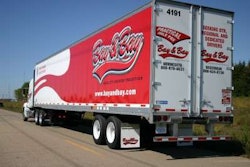Knight Transportation on Wednesday, Jan. 28, reported revenue and earnings for the fourth quarter and year ended Dec. 31. For the quarter, total revenue decreased 6.3 percent to $174.8 million from $186.5 million. Revenue before fuel surcharge decreased 5.5 percent to $143.6 million from $151.9 million. Net income increased 16.8 percent to $16.1 million from $13.8 million.
For the year, total revenue increased 7.5 percent to $766.9 million from $713.6 million for the same period of 2007. Revenue before fuel surcharge decreased 1.0 percent to $595.6 million from $601.4 million. Net income decreased to $56.3 million from $63.1 million.
“The fourth quarter operating environment was challenging and reflected the broad-based economic weakness that is now widely known,” said Kevin P. Knight, chairman and chief executive officer of the Phoenix-based company. “Typical seasonal shipping patterns did not hold, as volumes were uncharacteristically weaker in the quarter. This is the third consecutive year where a strong ‘peak’ shipping season did not materialize in the fourth quarter. Price competition remained intense as carriers struggled to maintain equipment productivity.”
Knight said that despite these challenges and the resulting year-over-year decline in revenue, the company was able to grow operating income by 20.7 percent. “Further, we generated $48.8 million in cash flow from operations and finished the quarter debt-free with $53.9 million in cash and short-term investments,” he said. “Profitability in the quarter was helped by falling diesel prices, ongoing internal initiatives to reduce costs, and the flexibility of our decentralized business model to adjust and adapt to market conditions.”
Knight said the company was grateful to its employees “during this time of unprecedented volatility and uncertainty. Their attention to detail, entrepreneurial spirit and commitment to our customers enable us to effectively utilize our decentralized business model. We believe that the depth of our employee talent within our service center network is one of our competitive advantages. Our front-line employees bring the ‘hometown carrier’ benefits to our customers and drivers, while leveraging the substantial resource of our national network.”
Knight said that despite nearly three years of challenging freight conditions, the company is confident that it made the right strategic decision not to dramatically reduce its fleet size. “Many large carriers have substantially reduced their fleets for either tactical or strategic reasons,” he said. “Further, a substantial number of small and mid-sized carriers have been forced into bankruptcy due to tight credit, high and volatile fuel prices and challenging industry pricing. We believe that this dynamic could eventually set the stage for tighter industry capacity and more favorable rates.”
Knight said the company believes its level of profitability, fleet renewal strategy and use of owner-operators should enable it to internally finance attractive levels of fleet growth when demand conditions improve. “Conversely, during times when we choose to maintain or trim our fleet levels, the business generates free cash flow that can be used for share repurchases, dividends or external growth opportunities,” he said. “Our current fleet of fuel-efficient 2007-emission compliant tractors is relatively young, and our service center network allows us to efficiently maintain this equipment. The company continues to have zero debt, and shareholders’ equity was $483.9 million at December 31, 2008. In short, we believe we have significant financial flexibility to meet the challenges and opportunities ahead of us.”












